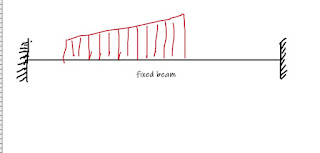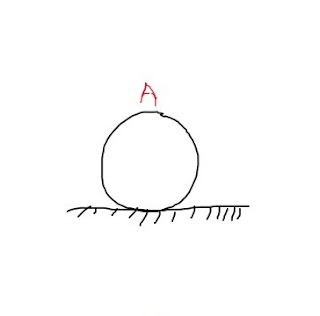ENGINEERING MECHANICS PART 1 , TYPES OF BEAM ,TYPES OF LOADING, TYPES OF SUPPORT
it helps to find the resultant of two forces from the graph, closing side of the triangle gives resultant
it is similar to the triangle law of forces but applicable to more than 2 forces
breaking force into a component like horizontal and vertical
fy = F sinФ
fx = F cosФ
if there are three forces acting on a point, if they are in equilibrium

summation of horizontal force = 0
summation of vertical force = 0
summation of moment = 0
simply moment = force * perpendicular distance
area of triangle * 2= moment about the apex of triangle ABC
varignon's theorem said that,
algebraic sum of individual forces (f1,f2,f3,f4)about P point = moment of resultant force about P point
f1*x + f2*y + f3*z = R*l
here x,y,z, and l are the perpendicular distances
forces which are equal in magnitude and opposite in direction called a couple
moment of couple = only one force magnitude * distance between the force
= f*d
you have to know about F.B.D (free body diagram), and support reaction
(1) simply supported beam
(2) cantilever beam
(3) overhanging beam
(4) fixed beam
(5) hinged beam
(6) roller supported beam
engineering mechanics is divided into two parts
1)static:
(in statics object's at rest like we apply force on the wall )
2) dynamic:
(in dynamic objects are under the action of forces like force tends to give motion to the object or stop the motion of the object)
dynamic is further divided into two parts :
(a) kinematic (time-space relationships)
(b) kinetics
1 System of forces :
a: collinear forces (line of action of forces are same)
b: concurrent forces(forces acting on the same point
c: co-planar forces(forces acting on the same plane )
d: co-planar concurrent forces
e: co-planar non-concurrent forces
f: non-coplanar concurrent forces
g: non-co-planar nonconcurrent forces
h: like parallel forces
i: unlike parallel forces
2 Composition and resolution of force :
(a) parallelogram law of forces:
Let P and Q be two vectors acting simultaneously at a point and represented both in magnitude and direction by two adjacent sides OA and OD of a parallelogram OABD as shown in the figure.
Let θ be the angle between P and Q and R be the resultant vector. Then, according to the parallelogram law of vector addition, diagonal OB represents the resultant of P and Q
here R is the resultant of two forces p & q
(b) triangle law of forces:
it helps to find the resultant of two forces from the graph, closing side of the triangle gives resultant
(c) polygon law of forces:
it is similar to the triangle law of forces but applicable to more than 2 forces
(d) method of resolution :
breaking force into a component like horizontal and vertical
in the given diagram assume F is given force then Fx and Fy will be given by
fy = F sinФ
fx = F cosФ
(e) LAMI'S THEOREM :
if there are three forces acting on a point, if they are in equilibrium

now find vertical and horizontal component then find resultant
and direction is
the sum of vertical forces/sum of horizontal forces
3 condition of equilibrium of forces :
summation of horizontal force = 0
summation of vertical force = 0
summation of moment = 0
4) MOMENT :
moments gives only rotation without displacement
simply moment = force * perpendicular distance
area of triangle * 2= moment about the apex of triangle ABC
5)VARIGNON'S THEOREM :
varignon's theorem said that,
algebraic sum of individual forces (f1,f2,f3,f4)about P point = moment of resultant force about P point
f1*x + f2*y + f3*z = R*l
here x,y,z, and l are the perpendicular distances
6)COUPLE:
forces which are equal in magnitude and opposite in direction called a couple
= f*d
you have to know about F.B.D (free body diagram), and support reaction
7)BEAMS:
(1) simply supported beam
(2) cantilever beam
(3) overhanging beam
(4) fixed beam
(5) hinged beam
(6) roller supported beam
8)LOADINGS:
(1) concentrated load (point load): in this diagram, P1 and P2 are the point load
(2) UDl (uniformly distributed load): notation of U.D.L is shown in the figure with red color
(3) UVL (uniformly varying load ): notation of U.V.L is shown in the figure with red color
(4) triangular load: notation of triangular load is shown in the figure with red color
9)VALUE OF LOAD AND ACTION ON POINT:
here w is the load per unit length
span length: where the load is distributed
and its action on the center of the span at L/2
value of UVL = ( (a*b)/2)*L
and its action on the center of the span at L/2
UVL:
value of UVL = ( (a*b)/2)*L
its act on L/3 from the apex side
in our example , apex is b
10)SUPPORT'S :
(1) HINGE SUPPORT: hinge support resist vertical and horizontal transformation but allow rotation
notation of hinge support given in diagram:
support reaction offered by a hinge support

























Good
ReplyDeletethnkyou for supporting
ReplyDeleteNice bro working hard keep it up we want to see more frequently post kindly attention to this. Thanks
ReplyDelete